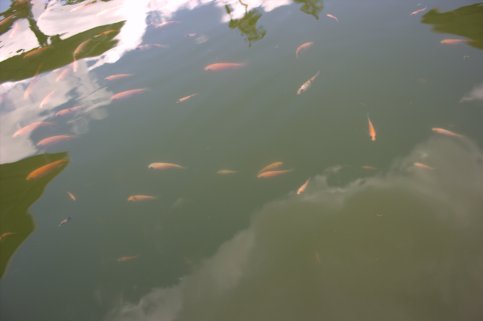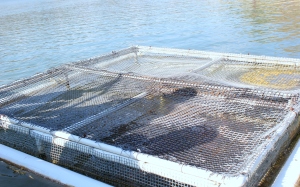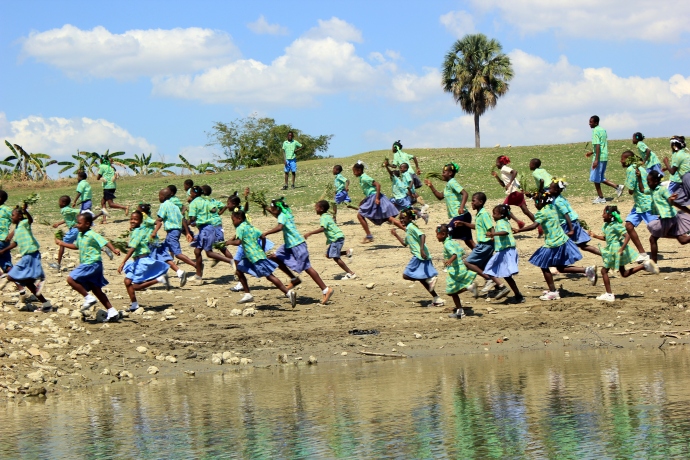What you don’t know about tilapia could fill a hatchery. Trust me on this.
When I went to Valentin Abe’s new, solar-powered, mega-cool Caribbean Harvest hatchery in the Central Plateau of Haiti, I was taking notes as fast as my fat little digits could write, and I still only got half of everything this awesome guy from the Ivory Coast (and Fulbright scholar at Auburn University… and one of Time‘s 100 most influential people in the world) told us about how farm fishing can transform the lives of the poor.
Tilapia farming starts with a bunch of brooders (doesn’t everything??) – whose genetic lineage can be traced back to the Nile. With oxygen pumped through the water that is sourced from the nearby river (filtered and cleansed), the brooders can breed at 4 months and will reproduce every six weeks (as long as you remove the baby fish so the mommies aren’t distracted). The female lays her eggs, the male fertilizes them, then mom incubates the eggs in her mouth (up to 2000 of them) for 4 days, then releases them, although they are still transparent and can’t be seen.
At 7 days of age, however, the babies become visible and instinctively head for the sides of the tank – where they can be removed with a fine mesh net in the cool of the early morning or late afternoon. The babies will then be transferred to separate tanks that hold 20,000 fish each, where they are fed, oxygenated and grown to 1/2″ long in about a month. At this point, the “fingerlings” are transferred in oxygenated plastic bags to nearby Lake Peligre where they are kept in cages owned by individual fishermen who will feed them three times a day for about 4 months.
When these babies get to be a pound apiece, each fishermen can sell his crop of 2000 tilapia for $2.40/pound (with $1.10 of that going to expenses) — for a profit of about $2500 per harvest. And that, my friend, is the beautiful rainbow at the end of this long tilapia road. It’s why Clinton Global Initiative has invested hundreds of thousands of dollars in the hatchery, Partners in Health is ordering all the tilapia for its brand-new hospital in Mirebalais from Caribbean Harvest farmers, Solar Electric Light Fund has installed the beautifully reliable, sophisticated solar system, and Heifer International is donating the $450 cages to Peligre fishermen.
Because once this operation gets up and running (it just came on line last month), it has the potential to produce 40,000 fingerlings a month — which would be a game-changer for the poor communities around Lake Peligre and the surrounding Central Plateau.Despite the fact that this is an island, Haitians eat only 4.4 pounds of fish a year (contrasted to the global average of 35 pounds) and the country imports $26 million of cod annually from Taiwan. The beauty of farming tilapia locally is that while it improves the protein-starved diet of Haitians, it also provides an income to farmers and fisherman living around the lake — and supports the schools in villages like Sylguerre that we were lucky enough to visit with Valentin Abe to see the school and witness tilapia farming in action.
Around the lake, 8 destitute schools with no government support are struggling to survive –with the help of Partners in Health and two teachers leading the Community Action for Education and Development around Lake Peligre(ACEDLP). Tilapia farming is an idea that can be scaled up quickly, produce sustainable profits, and enable the people to support their schools and get their children a good education.
The plan is for each fisherman to receive one free gift of 2000 tilapia fingerlings from Caribbean Harvest (and its sponsors) and a cage from Heifer International. After harvest, he will reinvest part of his proceeds in another crop of fingerlings, and then on the third harvest, put aside money to pass along the gift of a new cage to another farmer (Valentin estimates each farmer can harvest 3 crops of tilapia a year.)
There are still some kinks to be worked out: Abe found that 1/2″ tilapia babies survive better than the 2″ older ones during transfer, and the farmers have to perfect their feeding and distribution to prevent the fingerlings from perishing and get them to market while they’re fresh. But the potential is totally there for a sea change in the fishing industry of Haiti … with the beautiful Lake Peligre children on the line.
I’m in!















